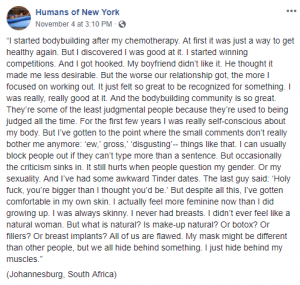Brandon Stanton’s massively popular blog “Humans of New York” (HONY), with over 18 million likes on Facebook, and two bestselling books, documents the diverse stories (and photos) of people in New York, later expanding to several other countries (“About”). It serves to make public the stories of marginalized people, and as the name suggests, to “humanize the ‘other’” (Erdener 374). I will establish that this is achieved through the use of affective (i.e. emotion-based) storytelling, a concept Anna Poletti examines thoroughly in her article “Coaxing an Intimate Public: Life Narrative in Digital Storytelling.” Utilizing Poletti’s observations of the inherent hegemony of digital life narratives, and the limitations of affective narratives (81), I will demonstrate that though HONY establishes a universal human connection (Erdener 374) between readers and subjects, it does not entirely fulfill its potential to effect real political change.
Poletti asserts that certain themes are common in life narratives, and she cites Burgess’ classification of these themes as those of “life, loss, belonging, hope for the future, friendship and love” (Burgess cited in Poletti 81). Poletti argues that digital life narratives often conform to our culture’s view of an ideal life, and thus aren’t fully capable of challenging this political and social hegemony (81).


Fig. 1 Screenshot of a HONY post: Stanton, Brandon. “I started bodybuilding after my chemotherapy…” Facebook, 4 Nov. 2018.
In its attempt to create a universal appeal to its readers, HONY unfortunately conforms to these ideals. In Fig. 1 alone we can see several examples of these themes; the subject’s sense of belonging (in the bodybuilding community), life (her triumph over cancer), and hope for the future (her growing self-acceptance in the face of intolerance). This conformity is likely elicited through guiding questions asked by Stanton. Especially when telling minority stories (as HONY often does), it is imperative to overcome hegemony, so the need for political change becomes apparent. In conforming to these ideals, however, HONY only ensures its stories are well received, it cannot encourage activism.
Poletti also draws attention to Berlant’s observations of the issues of affective narratives. Because they present pain and suffering as universal experiences, they create a sort of political apathy among readers; because suffering is universal, it can’t be helped. Thus, though these narratives do foster empathy, they cannot bring about real political change (Berlant cited in Poletti, pp. 80). As is evident in Fig. 1, HONY often utilizes emotional narratives. By situating the stories in feelings readers are familiar with, HONY creates a feeling of universal connection, but Poletti’s theory states it cannot do much more than that(80). Further, the nature of Facebook may “persuade [Stanton’s] audiences to click ‘like’ without having to do anything more” (Erdener 375), keeping in line with Poletti’s idea of political apathy.
Humans of New York documents the stories of marginalized people and cultivates an idea of a universal human experience that reminds us all how similar we are. However, its potential to bring about real political or social change is impeded by what Anna Poletti presents as the common issues of digital life narratives. In her article “Coaxing an Intimate Public: Life Narrative in Digital Storytelling,” Poletti proposes that these issues are the “inherent hegemonic function” (81) of the universality of digital life narratives, as well as their affective nature contributing more to a “vaguely civic-minded ideal of compassion” (Berlant cited in Poletti 80) than to any real change. Though it is true that in these ways HONY may not reach its full potential to effect change, it does “dismantle the otherwise pervasive narrative of irreconcilable differences” (Erdener 376), which is sorely needed in a world that too often focuses on those differences.
Works Cited
“About.” Humans of New York, 18 Sept. 2012, www.humansofnewyork.com/about. Accessed 6 Nov. 2018.
Erdener, Jasmine. “Humans of New York and Ethical Reflections in the Digital Age.” Communication and the Public, vol. 1, no. 3, Sept. 2016, pp. 372–376.
Poletti, Anna. “Coaxing an Intimate Public: Life Narrative in Digital Storytelling.” Continuum, vol. 25, no. 1, 2011, pp. 73-83.
Stanton, Brandon. “Humans of New York.” Facebook, 2010, www.facebook.com/humansofnewyork/. Accessed 6 Nov. 2018.
Stanton, Brandon. “I started bodybuilding after my chemotherapy…” Facebook, 4 Nov. 2018, www.facebook.com/humansofnewyork/photos/a.102107073196735/2645549015519182/?type=3&theater. Accessed 7 Nov. 2018.